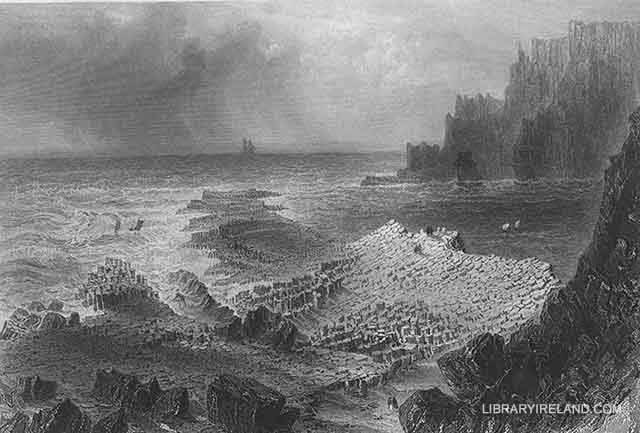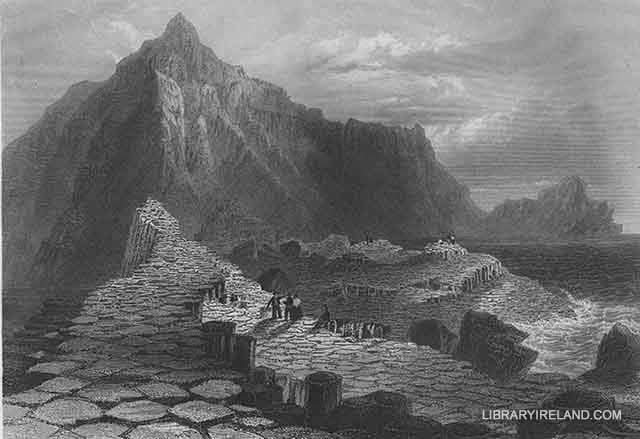First View of the Giant's Causeway, County Antrim
AFTER passing Dunseverick Castle, the road turns away from the shore, and makes nearly straight for the Causeway, leaving the promontory of Bangore Head far on the right. We were looking out anxiously for the Causeway; but even when within half-a-mile of it, the other headlands looked more attractive than the low line of the shore pointed out to us by the driver; and after seeing Fair Head, the whole of this shore might be passed by the undirected traveller without suspicion of the neighbourhood of wonders equal to those he had left behind. We stopped at the door of a low hut at last, and a very well dressed and intelligent-looking man made his appearance from the smoke, and offered his services as a guide. From the season in which we travelled, as well as from the early hour at which we arrived, we missed the throngs of beggars, guides, and mineral-sellers of which all travellers complain; but as we started on the path to the Causeway, we saw dark figures rising up in all directions, and radiating to us from a mile around, with every appearance of haste and expectation.
The guide led us down a slippery and stony road, cut in the side of the hill which concealed the Causeway from our view, and, rounding the shoulder of it, we descended to a small mound, from which we got our first view of THE CAUSEWAY. We were at too great a distance to distinguish any peculiarity in the view, except the lines of the basaltic pillars indistinctly marking the face of the cliff, and we were naturally disappointed with the first glance; but as we descended to the shore, and approached nearer around the bend of the bay, it seemed to us that the ruins of some templed and gigantic city, that had been hurled from the sky, were heaped up before us in a mountain of confused architecture. The Giant's Causeway, indeed, resembles nothing so much as a mountain of hewn stones—frusta of noble columns—remnants of vast porticoes, cast down from a height into the sea. The upright and regular pillars in the face of the cliff give you an impression that there is a city overwhelmed and buried behind them; and the disinterred Pompeii itself was not so like as this to the idea we had formed of Pompeii before visiting Italy.
Our guide kept on his way to the vast projecting quay which descends from the base of these mountain facades into the sea. To borrow the very correct language of a clever tourist—"The principal and grand causeway consists of an irregular arrangement of many hundred thousands of columns, formed of a dark rock nearly as hard as marble. The greater part of them are of a pentagon figure, but so closely compacted together that, though the pillars are perfectly distinct, the very water which falls upon them will scarcely penetrate between. There are some of the pillars which have seven, and a few which have eight sides; a few also have four, but only one has been found with three. Not one will be found to correspond exactly with the other, having sides and angles of the same dimensions; while at the same time the sum of the angles of any one of them is found to be equal to four right-angles—the sides of one corresponding exactly to those of the others which lie next to it, although otherwise differing completely in size and form. Each pillar is formed of several distinct joints, closely articulated into each other, the convex end of the one closely fitting into the concave of the next—sometimes the concavity, sometimes the convexity being uppermost. In the entire Causeway it is computed there are from thirty thousand to forty thousand pillars, the tallest measuring about thirty-three feet. Among other wonders, there is also the Giant's Well, a spring of pure fresh water, forcing its way up between the joints of two of the columns—the Giant's Chain, the Giant's Bagpipes, the Giant's Theatre, and the Giant's Organ, the latter a beautiful colonnade of pillars, one hundred and twenty feet long, so called from its accurate resemblance to the pipes of an organ."
The same tourist from whom we have quoted gives an amusing account of his stumbling upon a legendary explanation of the building of the Causeway. "In lately travelling," he says, "from Dublin to Belfast, we happened to enjoy as companions a 'traveller' from a Manchester firm, and a rough, ruddy-faced farmer from the black north. The conversation turned on the Causeway. 'Oh,' exclaimed the rider, 'I was there last spring; I just looked at it on my way from Coleraine to Ballycastle—never was so disappointed in my life—terrible cold coast, wind from the north-east enough to cut you in two—dreadful hungry place, I assure you, gentlemen—not a morsel to satisfy the cravings of nature, not even a tree to shelter the poor goats that were glad to hide themselves under the precipices. Irishmen should come and see our Giant's Causeway—the railway! that's a stupendous work, gentlemen!'
"The wrath of the man of Antrim was roused. 'You Englishmen,' said he, 'are all for the making of money. Why, man alive, if a dacent place that I know about is paved with goold, some of yees would be after getting a pickaxe to pocket the paving-stones. Didn't ould Fin M'Coul all as one as make that Causeway for the honour and glory of Ireland? and what's the use of talking about your dirty bit of a railway. Sure, ar'n't they going to have one from Dublin to Dunleary? We'll bate the conceit out of yees by-and-bye!'
"Mr. Trusselbags adjusted his neckcloth, and, with a knowing wink to me, rejoined: 'And pray, my good fellow, for what purpose did this Fin M'Coul make the Causeway? Perhaps you can tell us.'
"'With all my heart. You see, sir, a big Scotch giant, one Benandonner, used to brag that he would lick Fin M'Coul any day. And he used to go over the Highlands crowing like a cock on its own dunghill, that all he wanted was a fair field and no favour. So, by my souks, Fin M'Coul went to the King of Ireland, ould Cormac—may be ye've heard of him (there was no grand-jury presentments in them days)—and he says to his majesty, says he, I want to let Benandonner come over to Ireland without wetting the sole of his shoe, and if I don't lather him as well as ever he was lathered in his life, it's not myself that's in it. So Fin M'Coul got leave to build the Causeway, and sure he did, all the road clane and nate, to Scotland. And Benandonner came over wid his broadsword and kilt, and right glad he was to get a dacent excuse for laving his own country. He was bate, of course, though he stuck up like a Trojan; and then he settled in the place, and became obedient to King Cormac, and got a purty, dacent girl to his wife, and they say the great earls of Antrim are descended from them.'"


